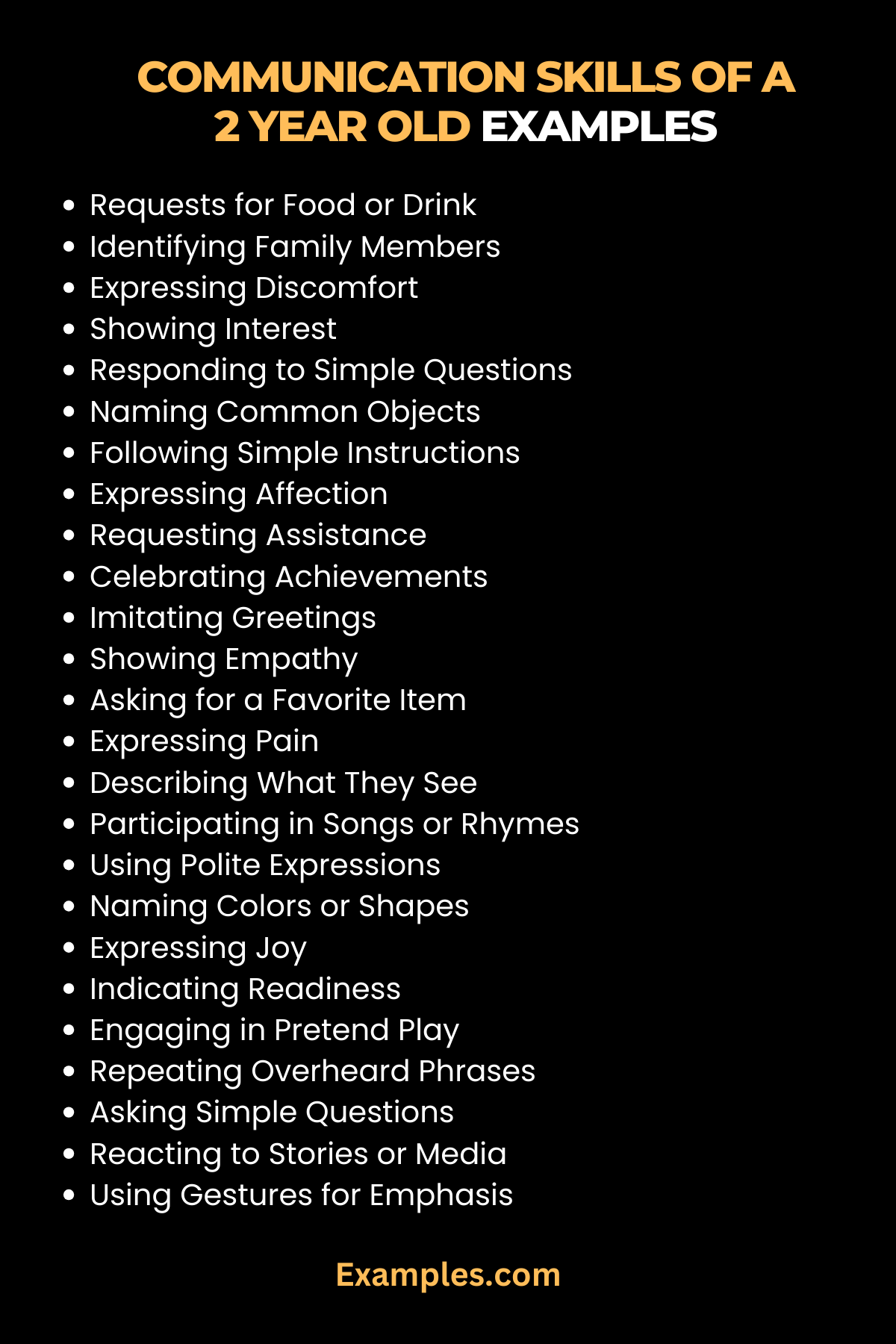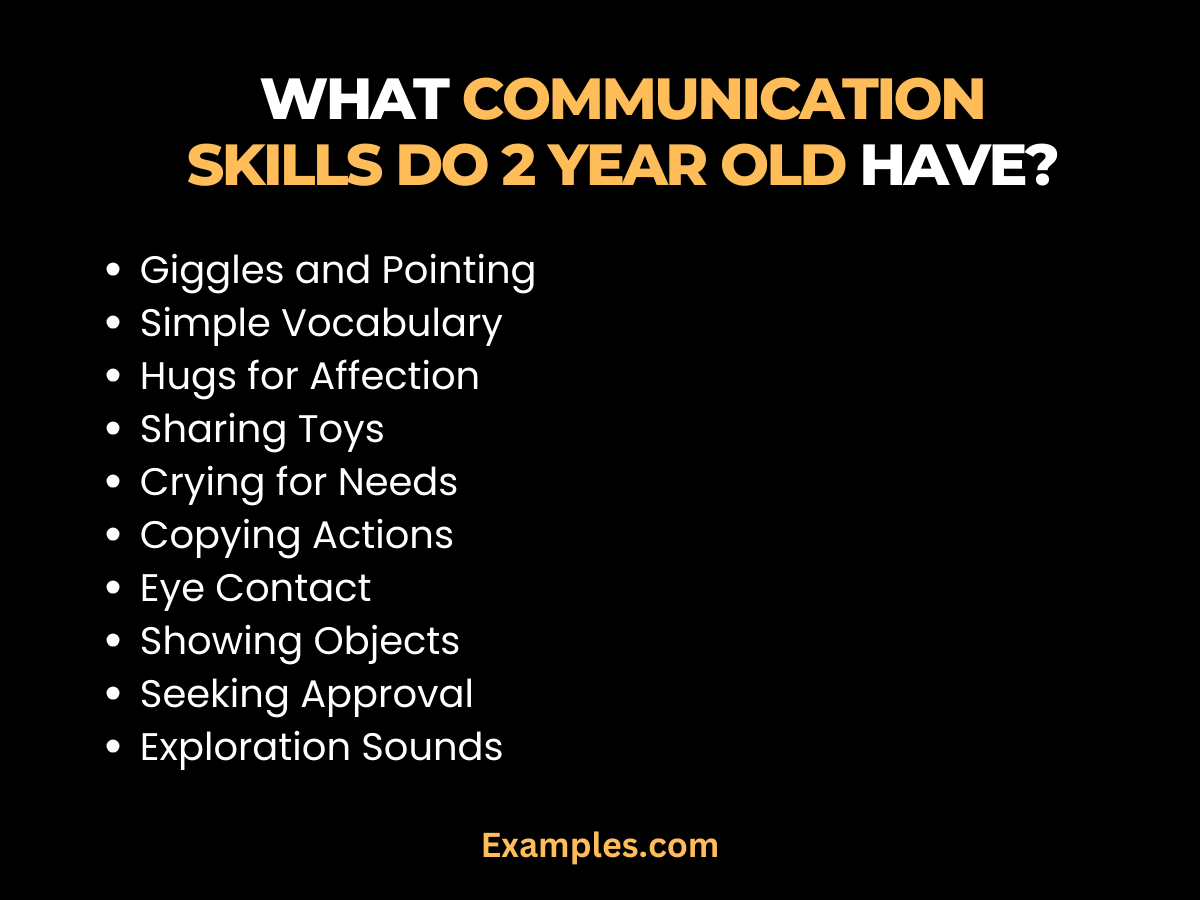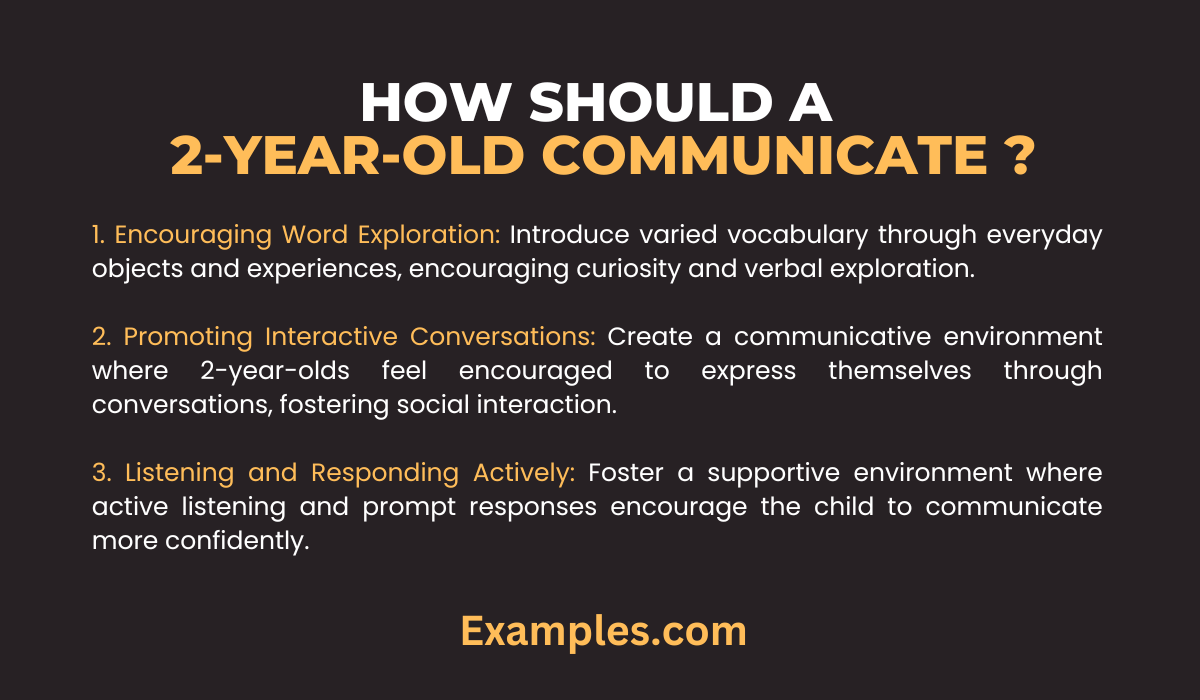29+ Communication Skills of a 2 Year Old Examples
Unlock the fascinating universe of a 2-year-old’s Communication Skills with our comprehensive guide. Navigate through practical tips, insightful advice, and charming Communication Examples that illuminate the toddler’s language journey. Explore the nuances of effective communication in simple English, fostering a strong foundation for your child’s verbal development. Immerse yourself in a world where each interaction becomes a delightful example of a 2-year-old’s burgeoning communication skills.
What is Communication Skills of a 2-year-old?
In simple terms, Communication Skills of a 2-year-old refer to the child’s ability to express and understand language. This includes gestures, sounds, and early words that enable them to convey thoughts, emotions, and needs. As toddlers embark on their language journey, developing effective communication skills lays the groundwork for future language acquisition and interpersonal interactions.
What is the Best Example of Communication Skills of a 2-Year-Old?
Nonverbal cues play a significant role in their communication. They might point to an object they want, shake their head for ‘no’, or nod for ‘yes’. Facial expressions and body language are also key, as they can show happiness, frustration, or curiosity without words. These skills are foundational for interpersonal communication and are critical in their overall development
Communication Skills of a 2 Year Old Examples
Communication skills in 2-year-olds are pivotal for their developmental milestones, encompassing a blend of verbal communication, nonverbal gestures, and effective communication techniques. At this age, toddlers rapidly expand their vocabulary and begin to form simple sentences. They also start understanding basic instructions and can express a range of emotions and desires. Observing these skills gives insight into their communication style and interpersonal communication abilities, essential for early childhood development.

- Requests for food or drink: A 2-year-old might say, “Want juice” or point to a bottle. This basic verbal request shows their understanding of using words to express needs.
- Identifying family members: Saying “Mama” or “Dada” not only names family members but also indicates recognition and attachment.
- Expressing discomfort: Phrases like “No bath” or “Bed no” reveal their ability to communicate dislikes or discomfort.
- Showing interest: Pointing at a toy or book and saying “This!” demonstrates curiosity and desire for interaction.
- Responding to simple questions: Answering “Yes” or “No” to questions like “Do you want milk?” shows comprehension and response skills.
- Naming common objects: Identifying objects like “ball” or “cat” reflects their growing vocabulary and communication skills.
- Following simple instructions: Understanding and acting on commands like “Come here” or “Sit down” marks a key development in oral communication.
- Expressing affection: Saying “Love you” or hugging shows their understanding of emotional expression.
- Requesting assistance: Phrases like “Help me” indicate their ability to seek help verbally.
- Celebrating achievements: Exclaiming “I did it!” after completing a task shows self-recognition and the ability to share accomplishments.
- Imitating greetings: Saying “Hi” or “Bye” appropriately demonstrates social communication skills.
- Showing empathy: Expressions like “Sorry” when someone is upset indicate developing empathy.
- Asking for a favorite item: Saying “Want teddy” shows preference and the ability to articulate specific desires.
- Expressing pain: Saying “Ouch” or “It hurts” indicates awareness of bodily sensations and the ability to communicate them.
- Describing what they see: Phrases like “Big truck” while pointing to a vehicle display observational skills and descriptive ability.
- Participating in songs or rhymes: Singing along to “Twinkle Twinkle” shows memory and rhythm recognition, important aspects of communication development.
- Using polite expressions: Saying “Please” or “Thank you” indicates understanding of social norms and courtesy.
- Naming colors or shapes: Identifying basic colors or shapes like “Red ball” or “Square” shows cognitive and verbal growth.
- Expressing joy: Exclamations like “Yay!” in happy moments reflect emotional expression skills.
- Indicating readiness: Saying “Ready” or “All done” shows understanding of process and completion.
- Engaging in pretend play: Using dolls or toys to mimic real-life scenarios reflects imaginative skills and narrative ability.
- Repeating overheard phrases: Mimicking phrases heard in conversation indicates auditory processing and retention.
- Asking simple questions: Queries like “Where kitty?” show curiosity and the ability to form basic inquiries.
- Reacting to stories or media: Responding with laughter or clapping during a story or song shows engagement and emotional response.
- Using gestures for emphasis: Nodding or shaking the head while speaking adds nonverbal emphasis to verbal communication.
- Recognizing and naming body parts: Identifying parts like “nose” or “foot” indicates body awareness and language connection.
- Expressing needs: Saying “Tired” or “Hungry” communicates bodily needs and self-awareness.
- Asking for repetition: Requests like “Again” when enjoying a game or song show preference and the ability to request continuation.
- Demonstrating possessiveness: Using “Mine” or “My toy” reflects understanding of possession and self-identity.
- Engaging in simple conversation: Responding in a back-and-forth manner during talk with adults or peers shows basic conversational skills
Communication Skills of a 2-Year-Old for Parent
Enhance your understanding of how 2-year-olds communicate with their parents. These tiny tots exhibit remarkable gestures, simple words, and adorable actions to express their feelings and needs. Nurture your parent-child connection by decoding their unique communication cues.

- Giggles and Pointing: Through joyful laughter and pointing, toddlers express excitement or interest.
- Simple Vocabulary: Encourage words like “mommy” or “daddy” to build early verbal connections.
- Hugs for Affection: Using hugs, a 2-year-old communicates comfort and love to their parents.
- Sharing Toys: By sharing toys, toddlers learn the art of cooperation and engagement.
- Crying for Needs: Tears communicate hunger, fatigue, or discomfort – deciphering their needs.
- Copying Actions: Imitating actions is a 2-year-old’s way of bonding and learning.
- Eye Contact: Maintaining eye contact conveys attention and connection.
- Showing Objects: Presenting objects signifies a desire to share experiences.
- Seeking Approval: Looking for approval signals a 2-year-old’s desire for recognition.
- Exploration Sounds: Experimenting with sounds is a playful way to capture attention.
What Language Skills Would You Expect a Typically Developing 2 year Old to Have?
Navigating the intricate world of a 2-year-old’s language and communication development is both rewarding and essential for parents and caregivers. During this pivotal stage, toddlers embark on a journey of acquiring language skills that extend beyond mere words. Here’s a comprehensive guide to understanding and fostering the rich landscape of Communication Skills in 2-year-olds.
- Early Vocabulary Expansion: Encourage the use of simple words, fostering the foundation for a robust vocabulary.
- Gestures and Nonverbal Communication: Explore the significance of gestures and nonverbal cues in a 2-year-old’s expressive repertoire.
- Understanding Toddler Babble: Decode the charming babble as toddlers experiment with sounds and syllables.
- Initiating Simple Conversations: Encourage interactive exchanges, allowing the toddler to initiate basic conversations.
- Enhancing Social Interaction: Promote positive social skills, aiding in effective communication with peers.
- Storytelling Through Play: Harness the power of imaginative play to stimulate language development.
- Building Listening Skills: Cultivate active listening habits in 2-year-olds, vital for effective communication.
- Encouraging Two-Way Communication: Foster an environment where toddlers feel encouraged to express themselves freely.
- Expanding Repertoire of Expressive Language: Witness the blossoming of expressive language skills, including emotions and desires.
- Introducing Simple Instructions: Guide toddlers through following basic instructions, aiding in comprehension.
How Should a 2-Year-Old Communicate?
Navigating the development of a 2-year-old’s communication skills is a fascinating journey. This guide explores key aspects of fostering language development in toddlers, emphasizing effective communication strategies for parents and caregivers. Discover practical tips, engaging activities, and expert insights to nurture your child’s speech and language abilities during this critical stage of early development.

- Encouraging Word Exploration: Introduce varied vocabulary through everyday objects and experiences, encouraging curiosity and verbal exploration.
- Promoting Interactive Conversations: Create a communicative environment where 2-year-olds feel encouraged to express themselves through conversations, fostering social interaction.
- Utilizing Gestures and Body Language: Recognize the importance of non-verbal communication, such as gestures and body language, as crucial components of early speech development.
- Storytelling and Imaginative Play: Engage in storytelling and imaginative play to stimulate a 2-year-old’s creativity, expanding their linguistic capabilities.
- Listening and Responding Actively: Foster a supportive environment where active listening and prompt responses encourage the child to communicate more confidently.
- Repeating and Reinforcing Words: Reinforce language acquisition by repeating words, gradually expanding their vocabulary and reinforcing comprehension.
- Introducing Simple Questions: Gradually introduce simple questions to encourage 2-year-olds to express themselves and articulate their thoughts.
- Celebrating Achievements: Acknowledge and celebrate communication milestones, creating a positive association with language development.
- Incorporating Daily Routine Conversations: Integrate language into daily routines, such as meals or bedtime, enhancing communication skills through consistent interactions.
- Seeking Professional Guidance if Needed: Recognize when professional guidance might be beneficial, ensuring any potential speech delays are addressed promptly.
What Communication Skills do 2 year Old Have?
Understanding the intricacies of “What Communication Skills Do 2-Year-Old Have?” is pivotal for parents and caregivers. At this tender age, toddlers embark on a fascinating journey of language development, showcasing a repertoire of communication skills that go beyond simple expressions. Here’s a comprehensive guide to unravel the linguistic marvels of 2-year-old.
- Vocabulary Explosion: By the age of 2, toddlers exhibit a blossoming vocabulary. Witness the magic as they grasp and mimic words from their surroundings.
- Simple Sentence Formation: Building on their vocabulary, 2-year-old begin stringing words together, crafting basic sentences to express their thoughts.
- Gestures and Nonverbal Cues: Beyond words, toddlers adeptly use gestures, pointing, and facial expressions to convey emotions and intentions.
- Imitating Sounds and Tones: 2-year-old enjoy mimicking sounds, showcasing an early inclination towards tone modulation and speech patterns.
- Understanding Simple Instructions: Toddlers demonstrate the ability to comprehend and follow straightforward instructions, marking a significant cognitive leap.
- Expressing Emotions Through Words: Developing emotional intelligence, 2-year-old articulate feelings, whether it’s joy, frustration, or excitement.
- Initiating Social Interactions: Witness the emergence of social skills as toddlers initiate interactions, attempting to engage with peers and adults.
- Identifying Familiar Objects: With an expanding cognitive toolkit, toddlers identify and name familiar objects in their environment.
- Narrative Attempts: Encourage storytelling endeavors as 2-year-old embark on simple narratives, weaving together experiences and events.
- Asking Simple Questions: Curiosity blooms, prompting 2-year-old to ask basic questions, signaling an eagerness to explore the world.
How to Improve Communication Skills for a 2-Year-Old?
Enhancing a toddler’s communication skills involves patience, creativity, and understanding their developmental stage. Follow these practical strategies to foster effective verbal expression in your 2-year-old:
- Encourage Simple Words: Introduce basic vocabulary by repeating and reinforcing words frequently. Celebrate every attempt, building their confidence.
- Engage in Storytelling: Stimulate imagination through storytelling. Use simple narratives and colorful visuals to captivate their interest.
- Interactive Playtime: Opt for interactive games that involve communication, such as naming objects or playing pretend scenarios.
- Express Emotions Together: Teach emotional expression by labeling and discussing feelings. This helps them articulate their own emotions.
- Imitate Their Sounds: Respond to their babbling with enthusiasm. Imitating their sounds encourages them to experiment with language.
- Use Visual Aids: Incorporate visuals like picture books or flashcards to associate words with images, aiding comprehension.
- Create a Communication-Rich Environment: Surround your child with language-rich experiences, from singing songs to describing daily activities.
- Practice Active Listening: Cultivate active listening skills by responding attentively to their attempts at communication. This builds a sense of connection.
- Introduce Sign Language: Supplement verbal communication with simple sign language. This empowers them to express needs non-verbally.
- Celebrate Milestones: Acknowledge and celebrate each milestone in their communication journey, fostering a positive attitude toward learning.
In conclusion, unlocking the world of a 2-year-old’s communication skills is a journey filled with joy and discovery. From adorable gestures to the emergence of simple vocabulary, this guide provides valuable insights and practical examples. Nurturing these early communication skills lays a foundation for strong parent-child bonds and sets the stage for continued language development. Embrace the wonders of toddler communication with confidence and delight



